Reading Landscapes
US photographer shoots lotus and wider landscapes during her 30 years of trips across China
Having traveled in China for much of the past 30 years, American photographer Lois Conner describes herself as an "obsessive collector and observer of landscape."
To celebrate the 30th anniversary of her first photographic trip to China, Conner is showing a selection of her platinum prints at the exhibition titled Reading Landscapes in Shanghai.
Works on display focus on the lotus, a reoccurring subject under her lens. In some photos, wilted wintry stems are bent limply in different angles above still water, while in others, lush leaves are densely covered with glistening water drops. The contrasting depictions of the water plant strike a poetic balance between bloom and gloom, force and fate, order and chaos.
In her works, Conner seems capable of turning the foul and rotten into the rare and ethereal. One photo shows the lotus underneath the ice. "Even when they are dying, they still hold some kind of energy. They look dead, but they still connect to the bottoms," Conner said.
Conner took her first lotus photos at Shao Yuan, part of an old imperial garden at Peking University, when she was studying there. "When I started seeing them every day, something clicked and I became very interested," she said.
"I'm less interested in the lotuses that are blooming. I'm more interested when the season is waning and the sticks and leaves are dying. They become calligraphic." All the photos on show were shot with her 70-pound panoramic banquet camera, a type of large format camera originally used in the 19th century for photographing large gatherings at long banquet tables, as the format and negatives can give an equally sharp focus on all guests.
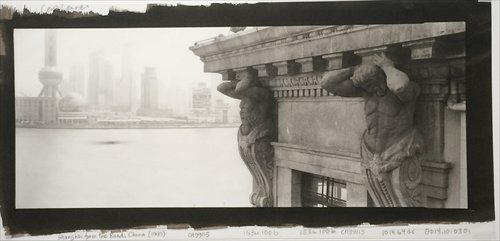
American photographer Lois Conner's works about landscapes in China are on display at M97 Project Space. Photos: Courtesy of M97 Gallery Shanghai (m97 gallery.com)
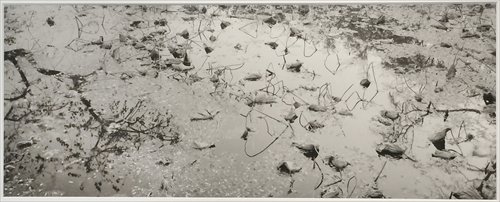
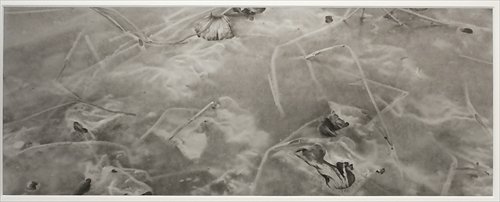
A narrative power
Conner's camera produces a 7- by 17-inch negative whose aspect ratio comes close to that of traditional Chinese scroll paintings. The long rectangular film format holds a narrative power, inviting the viewers to move their eyes through the cinematic scenes from one side to the other for a more detailed and thorough examination of the subjects.
Conner has spent much time at China's Yuanmingyuan, or the Old Summer Palace in Beijing and West Lake in Hangzhou photographing lotus. She usually takes a long time when she photographs because she wants to walk around and look at the landscape. Working with the camera also takes time. She said she wants the details to be fine. So the work is very deliberate and gives her an excuse to pause, to gaze, to study and to admire.
"I never know what I will find. Each day brings thrilling discoveries as well as inevitable frustrations and disappointment. But the lotus has become my muse. And it subsequently informs how I approach other landscapes," she said.
From the Gobi Desert to karst formations, from bamboo scaffolds to glistening skyscrapers, Conner's sweeping vistas chart the country's great diversity and the monumental transformations she's seen with her own eyes.
Landscape photos taken in Beijing, Shanghai, Hangzhou and Zhangjiajie are also showcased at the exhibition. The photos were handprinted by Conner in her New York studio using the platinum photographic printing process, which provides warm grays and a great tonal range.
She was introduced to the hanging scrolls of the Ming Dynasty (1368-1644) and the landscapes of southern China while studying photography at Yale. In 1984, she came to China on a Guggenheim Fellowship and has returned every year since.
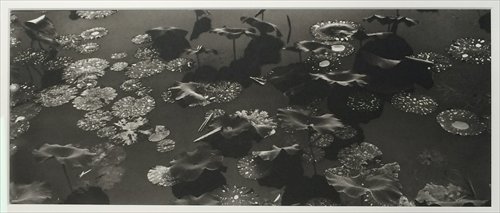
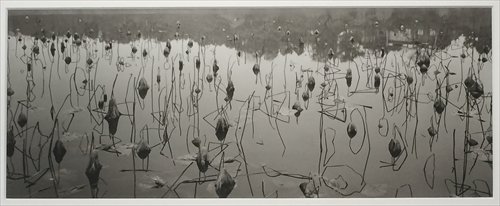
Traveling alone
Conner travels alone across the country, documenting the landscapes and people, ancient ruins and modern high-rise buildings. She also travels on the borders to see how the country's landscape has been influenced by other cultures.
"I don't think I would have been able to experience that kind of transition in any other country during my lifetime. It was very rapid. What I'm trying to reveal through photography in a deliberate yet subtle way is a sense of history. I would like my photographs to describe my relationship between the tangible and the imagined, between fact and fiction."
One of Conner's favorite poems is At Deer Fence by Chinese poet and painter Wang Wei (701-761). It goes like this: "No one on sight on the empty mountain/But their voices are heard/The sun slants deep in the mountains/And the green moss lights up again."
"This blind kind of beauty is my imagination," Conner said. "The poem echoes my experience of the landscape in China, even though those experiences change over time, so does my interpretation of the poem. Sometimes I feel alone in a vast landscape, but as the poem itself specifies, voices are heard always. I'm never alone."
After three decades' traveling, the landscape reader has even become part of the landscape herself.
Date: Until December 14, 10 am to 6 pm
Venue: M97 Project Space
M97项目空间
Address: Room 102, Bldg 3, No.1, Lane 170 Yueyang Road
岳阳路170弄1号3号楼102室
Admission: Free
Call 6266-1597 for details